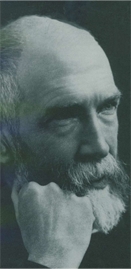George
Monro Grant
On
the Cusp of Nation Building 1835-1902
The emergence of
a new nation in 1867 required leaders to forge consensus and unity across
a diverse landscape. Having such men as the eminent George Monro Grant,
Canada was well provided. Best known for inspiring Queen’s University of
Kingston to become one of North America’s most prominent and respected
institutions, he also reflected, through public service and national promotion,
the concept of Canada as more than a series of colonies gathered together
under imperial unity.
Born in 1835 in the
Scottish enclave that was Pictou County, Nova Scotia, George attended two
of the colony’s most dynamic educational institutions: Thomas McCulloch’s
Pictou Academy and James Ross’s West River Seminary and then graduated
from the University of Glasgow with degrees in theology. As a Presbyterian,
he espoused a more liberal Evangelical stance rather than a rigid Calvinist
one. He saw harmony between faith and reason and expressed his concern
for the socially repressed in espousing a social gospel. Through conciliation
and compromise, in 1875 he helped unify disparate formations into the Presbyterian
Church in Canada and became its moderator in 1889. Prominent in the Pan-Presbyterian
Alliance, he travelled around the world in 1888 to study comparative religions,
spoke at the Congress of Religions in Chicago in 1893, and published The
Religions of the World in 1894.
Stirred by the idea
of a Canadian federation, he expressed his own surge in national feeling
by twice crossing the country from east to west with his close friend Sir
Sandford Fleming. The first adventure resulted, in 1872, in Grant’s book,
Ocean to Ocean, which described the newly acquired lands on which the Canadian
west would be built. Although both trips were undertaken to seek the most
appropriate route for a transcontinental railway, Grant’s fascination with
the land and its culture resulted, between 1882 and 1884, in the vastly
popular publication called Picturesque Canada. Grant’s vision of Canada
was very much a part of his wider concept of imperial federation in which
the new country would become an equal partner in the British Empire. He
was a founding member of the Canadian Branch of the Imperial Federation
League in 1884. (His son William Lawson Grant married the daughter of another
imperial promoter, Sir George Parkin, and their grandson, George Parkin
Grant, became one of Canada’s most prominent philosophers and nationalists.)
 |
A
nation builder, George Munro Grant inherited a small and financially unstable
denominational college in 1877 and for the next 25 years, until his death,
turned Queen’s University into one of Canada’s most respected institutions
of higher learning. Editor and co-author of the tremendously popular Picturesque
Canada (1882), “Mr. Principal” was a charter member of the Royal Society
of Canada and its president in 1901. [Photo, courtesy National Archives
of Canada/C-37819] |
When Principal Grant
of Queen’s assumed his position in 1877, the Presbyterian college had a
student population of only 90. When he died in 1902, he was the head of
a non-denominational university of international reputation with an enrollment
of 850. Grant instilled, in its faculty and students, an ethic of public
service, promoted understanding between the sacred and the secular, and
pioneered both scientific education and extension programs. Queen’s pioneered
advanced education for women when it admitted women to regular classes
in 1879; furthermore, the institution opened a Woman’s Medical College
in 1883.
While political parties
and business groups were putting a stamp on the new nation in late Victorian
times, George Monro Grant – educator, minister, and author – had a broad
cultural vision of the emerging country. Ultimately, Canada would become
much greater than its disparate parts owing to the direction given by nation
builders such as George Grant who saw the land and the culture and defined
a purpose well before most Canadians had the opportunity of going from
sea to sea themselves.
Larry Turner